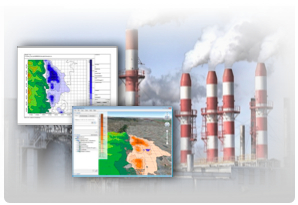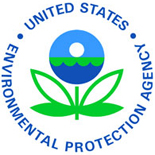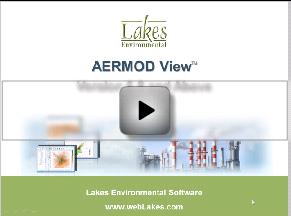Lakes Environmental e-Newsletter
In this issue:
- News & Events
- Upcoming Courses
- Modeling Tip: Using AERMOD View to Model 1-Hour NO2 NAAQS
- Articles
- Upcoming Conferences & Trade Shows
News & Events
AERMOD View Version 6.8.6 Released
|
Lakes Environmental is proud to announce the release of AERMOD ViewTM 6.8.6 on March 8, 2011. AERMOD View Version 6.8.6 includes the following updates:
|
 |
If you are currently in maintenance for AERMOD View and did not receive an email regarding this update, please contact us at support@webLakes.com.
If you are a user of AERMOD View but are no longer in maintenance please contact LakesSoftware@webLakes.com to find out how you can begin using AERMOD View Version 6.8.6!
US EPA Upcoming Release of AERMOD, AERMET, and AERMINUTE
The US EPA is in the final stages of releasing a major update to AERMOD and AERMET (most likely dated 11059) . Draft users guide addendums for AERMOD, AERMET, and AERMINUTE were released on March 4, 2011. An updated version of AERMOD View will be made available to users in current maintenance shortly after US EPA’s official release. The following provides a summary of key changes and new features associated with each of these updates:
New Options for the AERMOD Model:
|
New Options for the AERMET Model:
|
The New AERMINUTE Program:
AERMINUTE was developed by the US EPA as a solution to reduce the high incidence of calms and missing or variable wind conditions reported in ASOS data. A high incidence of calms and missing wind creates a significant problem since AERMOD cannot currently simulate dispersion under calm or missing wind conditions. Using AERMINUTE, it is now possible to reduce the number of calms and missing winds by generating hourly averaged winds derived from archived 1-minute ASOS data. AERMET View will be updated to take full advantage of the capabilities available in AERMINUTE.
Additional detailed information is available on the USEPA SCRAM Website. Convenient links for each updated are available below:
US EPA AERSCREEN Version 11076 Released
The USEPA officially released AERSCREEN Version 11076 on March 17, 2011. This recent release of AERSCREEN includes the following significant updates:
AERSCREEN is intended for use as a screening level air quality model to represent worst case impacts. AERSCREEN is based on AERMOD and consists of two primary programs:
1) MAKEMET - used to generate a non-sequential meteorological data file that represents a matrix of met conditions which ensures worst case impacts are estimated.
2) AERSCREEN - used to estimate worst case impacts. AERSCREEN forces AERMOD to represent calculations for the plume centerline, irrespective of wind direction, source location, and receptor orientation. This screening program supports point, rectangular area, circular area, volume, capped stack, horizontal stack, and flare source types and can generate 1-hour, 3-hour, 8-hour, 24-hour, and annual average worst case impacts. AERSCREEN also interfaces with AERMAP and BPIPPRM to automate the processing of terrain and building.
Additional details are available on the USEPA SCRAM Website: https://www.epa.gov/ttn/scram/dispersion_screening.htm#aerscreen.
AERMOD & CALPUFF Courses in Las Vegas, Nevada – May 16-20, 2011
Lakes Environmental is pleased to be presenting a full week of AERMOD and CALPUFF training in Las Vegas, Nevada from May 16 to 20, 2011. Attending these courses is the best way to stay current with recent regulatory and methodology changes. Lakes Environmental uses cutting edge tools that will revolutionize the way you do air dispersion modeling! Spaces are filling up fast! Register soon in order to reserve your spot. Further details including course venue and registration form can be found on our website. |
Upcoming Courses

Date |
Course |
Location |
Registration |
Apr 11-12, 2011 |
FULL |
||
Apr 13-15, 2011 |
|||
May 16-17, 2011 |
|||
Jun 6-7, 2011 |
|||
Jul 11-13, 2011 |
|||
Sep 12-13, 2011 |
|||
Sep 14-16, 2011 |
|||
Oct 3-4, 2011 |
|||
Oct 17-18, 2011 |
|||
Nov 17-18, 2011 |
For more information on the above courses, including registration information, location, and course outlines, please visit our web site: https://www.weblakes.com/courses.html.
Modeling Tip
Using AERMOD View to Model 1-Hour NO2 NAAQS
Lakes Environmental's AERMOD View Version 6.8.6 has an integrated post-processor that can perform the necessary calculations and present the results in a standard plot file format for all the new US EPA NAAQS 1-hour SO2, 1-hour NO2, and 24-hour PM2.5.
The steps are easy. The user simply needs to select the option in the Control Pathway, specify the desired Source Groups, run the AERMOD model, and get all the results necessary for the analysis, including contributions from each source group.
The video below shows you how straight forward it is to set up your AERMOD View project for modeling 1-hour NO2 NAAQS according to the latest US EPA guidelines.
Submit Your Modeling Tip Today!
We are currently accepting submissions for the Monthly Modeling Tip section that appears in our newsletters. If you have a modeling tip that may benefit our readers, please send it to us at support@weblakes.com. Your name and the name of your organization will appear below the tip providing you with an opportunity for increased exposure.
Articles
EPA Updates Database on Health and Environmental Impacts of Electricity Generation/ User Friendly Web Tool Allows Americans to Search for Power Providers by Zip Code
WASHINGTON - March 8, 2011 - The U.S. Environmental Protection Agency updated its database that helps Americans understand the health and environmental impacts of electricity generation. EPA’s Emissions and Generation Integrated Resource Database (eGRID) and Power Profiler now include data from 2007, an update from 2005.
eGRID is a comprehensive database of emissions from almost all electric power generated in the United States. The data are widely used to show the impacts of electricity generation as well as the benefits from reduced electricity demand. eGRID contains emissions information for nitrogen oxides (NOx) and sulfur dioxide (SO2) which contribute to unhealthy air quality and acid rain in many parts of the country. eGRID also contains emissions information for carbon dioxide (CO2), methane (CH4), and nitrous oxide (N2O), which are greenhouse gases that contribute to climate change.
EPA Announces Next Steps for Greenhouse Gas Emissions Reporting Program
WASHINGTON - March 1, 2011 - WASHINGTON – The U.S. Environmental Protection Agency is announcing that its Greenhouse Gas (GHG) Reporting Program has recently completed extensive work to develop GHG data reporting requirements for a wide range of different industries in response to Congressional mandates. This program will provide Congress, stakeholder groups and the public with information about these emissions while helping businesses identify cost effective ways to reduce emissions in the future.
To ensure that the requirements are practical and understandable to the thousands of companies already registered to report under the program, the agency is in the process of finalizing a user friendly online electronic reporting platform.
Government of Canada Begins Regulation of Products Containing Mercury
OTTAWA - February 28, 2011 - OTTAWA, Ont. -- February 28, 2011 -- The Honourable Peter Kent, Minister of the Environment, and the Honourable Leona Aglukkaq, Minister of Health, today announced the start of a regulatory process to prohibit the manufacture, import, and sale of most mercury-containing products in Canada.
"These proposed regulations would eliminate about four and a half tonnes of mercury in products currently entering the Canadian marketplace each year. It is the first time that the Government of Canada is broadly regulating mercury found in manufactured products," said Minister Kent.
"Mercury is a neurotoxin. Ingesting methylmercury can affect the neuro-development and learning ability of small children. Keeping products that contain mercury out of the marketplace helps to protect the health of Canadians," added Minister Aglukkaq.
Chemicals/REACH: Six Dangerous Substances to be Phased Out by the EU
February 17, 2011 - Six substances of very high concern will be banned within the next three to five years unless an authorisation has been granted to individual companies for their use. These substances are carcinogenic, toxic for reproduction or persist in the environment and accumulate in living organisms. Operators wishing to sell or use these substances will need to demonstrate that the required safety measures have been taken to adequately control the risks, or that the benefits for the economy and society outweigh the risks. Where feasible alternative substances or techniques exist, a timetable for substitution will also have to be submitted. Today’s Commission decision follows the successful first phase of registration and notification of chemicals (see IP/10/1632, IP/11/2). It is part of REACH, Europe’s initiative to make the use of chemicals safer.
Harper Government Moves Forward With Regulations for Renewable Fuel Content in Diesel Fuel and Heating Oil
HAMILTON - February 10, 2011 - The Harper Government today announced that it is moving forward with the requirement for an average 2 per cent renewable content in diesel fuel and heating oil.
"When we announced our Renewable Fuels Strategy, we were clear that the 2 per cent requirement would be implemented subject to technical feasibility," said the Honourable Peter Kent, Minister of the Environment. "After positive results, we are moving forward with this requirement which will result in further reductions in greenhouse gas emissions and ultimately in cleaner air for all Canadians.''
"We are meeting the commitments we have made to farmers, rural communities and industry to regulate the use of renewable fuels," said Agriculture Minister Gerry Ritz. "The new renewable fuel content in biodiesel and heating oil will give our farmers another market for their crops and demonstrates how agriculture can contribute to reducing Canada's environmental footprint."
Upcoming Conferences & Trade Shows
Date |
Conference |
Location |
Mar 22-24, 2011 |
AMERICANA 2011 |
Montreal, QC, Canada |
May 9-12, 2011 |
WasteExpo |
Dallas, TX, USA |
May 11-12, 2011 |
33rd Motorship Propulsions and Emissions Conference |
Copenhagen, Denmark |
May 16-18, 2011 |
CANECT 2011 |
Mississauga, ON, Canada |
May 29-31, 2011 |
Gulf Environment Forum 2011 |
Jeddah, Saudi Arabia |
Jun 14-16, 2011 |
GLOBE Costa Rica 2011 |
San Jose, Costa Rica |
Jun 21-24, 2011 |
A&WMA's 104th Annual Conference & Exhibition |
Orlando, FL, USA |
Jul 21-22, 2011 |
Third International Conference on Climate Change |
Rio de Janeiro, Brazil |
Sep 19-21, 2011 |
19th International Conference on Modelling, Monitoring and Management of Air Pollution |
Malta |
About this Newsletter
This newsletter contains information gleaned from various sources on the web, with complete links to the sources cited. Organizations cited are in no way affiliated with Lakes Environmental Software.
Lakes Environmental Software is a leading environmental IT company that offers a complete line of air dispersion modeling, risk assessment, emissions inventory, and emergency release software as well as training and custom software services. With satisfied users located around the globe, Lakes Environmental Software will continue to revolutionize the environmental software field.
For more information please visit our web site at: www.weblakes.com. You may also contact us by phone at (519) 746-5995 or by fax at (519)746-0793.
All comments and suggestions are welcome. You can e-mail us at: support@weblakes.com.






